The BIBLICAL FLOOD, NOAH'S FLOOD,
the deluge of the Scriptural Genesis record
Presenting Biblical research into the
Biblical flood, Noah's flood, including scientific evidences and Biblical Hebrew and Biblical Greek meanings.
"The water having poured over the terrestrial disk,
human dwellings disappeared. The wind carried them away.
They fastened several boats to one another.
The waves traversed the Rocky Mountains.
A great wind drove them.
Presently the moon and the earth disappeared.
Men died of a terrible heat.
They also perished in the waves.
Men bewailed what happened.
Uprooted trees floated about in the waves.
Men having fastened boats together trembled with cold.
Alas, men were enclosed under the tent without doubt."
The above translation is attributed to the native tribe called the
Esquimaux of Canada. Just one of hundreds of flood traditions that
many scholars have collected.
Also from further south in the Carolinas we have the following very
interesting tradition:
"a star fell to the earth,
and rain soon followed.
Days and days of rain quenched the fire.
Great holes burned
in the earth by the fire were filled,
forming a great inland sea.
The above traditions would seem to be describing a super super
hurricane combined with a burning effect due to the impact of the star.
If you need a reminder of just how destructive a major hurricane can be
see Mitch.
One survey of 40 traditions of global
water destruction, which included traditions that circled the globe and
included most major centers of population and many island tribes,
showed that they verified the major principles of the Genesis record as
follows.

(from Byron C. Nelson, The Deluge Story in Stone (Augsburg, Minneapolis, 1931),
Appendix II, Flood Traditions, Figure 38)
Human seed saved-92%
Boat provided-87%
Universal Destruction-60%
Favored Family-38%
Man in transgression-35%
Divine Destruction-28%
Birds sent out-22%
Animal seed saved-20%
Survivors worship-18%
Divine favor on saved-12%
In looking for a possible natural catastrophic cause of the great flood
many theories have been proposed. Looking back at the Esquimaux tradition we
note the following characteristics. High water, strong wind, high heat, large waves,
uprooted and floating vegetation, and trembling cold.
One possible scenario which might account for a majority of these factors is large amounts
of volcanic type activity along portions of the subsurface ocean ridges for a
short time. Fig 1 below shows examples of the type of activity that can
happen along the earth's surface plate lines and Fig 2 shows the present
configuration of the subsurface ridge areas. Note the massive size of the
mid-Atlantic ridge! ( Information on plate tectonics may be seen at
http://www.platetectonics.com )
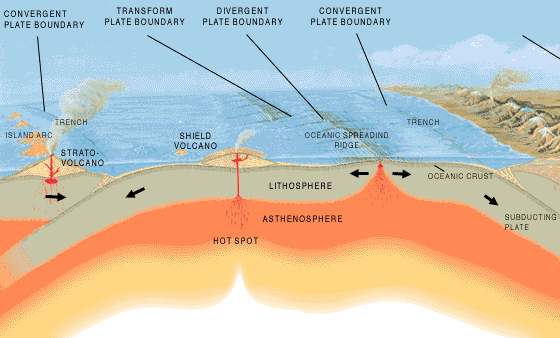 Fig1
Fig1
 Fig2
Fig2
Should greatly increased activity along the plate lines cause heating of
the oceans along these lines there would be many large and terrible
"super" storms which would greatly disturb the climate of the entire globe.
NOAA is currently doing research on the subsurface plate lines and they have
discovered many indicators of recent and current subsurface activity. And nearly all
scientists agree that the materials along the subsurface spreading ridge lines
are of recent origin. It is also possible that the flow could be of such a magnitude
as to cause changes in the sea level. For example, the surface flow area of the
Columbia lava plateau covers over 200,000 square miles and in places is up
to a mile thick. Also possibly the polar ice caps would be temporarily melted.
After the volcanic activity stopped there would be a transition period as climatic
activity decreased and lesser affected areas of the extreme north and south continents would
return to frigid climates, but with greatly increased moisture in the atmosphere
it is theorized that an ice age would result.
We all know how catastrophic can be
the effects of only a 3 degrees Centigrade increase of ocean surface temperature
due to the past El Nino.
When El Nino is active, a giant high pressure system centered near Easter Island
drops slightly in pressure and touches off a change in Pacific currents, bringing
warmer water in certain areas and colder water to others. An area 600 miles
northwest of Easter Island was found to have 1133 seamounts and volcanoes,
far more than any other area known on dry land or under the ocean. In 1995, scientists
reported that a spate of undersea quakes and lava eruptions had preceded the
onset of the El Nino cycle then in effect. Dr. Daniel A. Walker, a geophysicist
at the University of Hawaii, said that the seismic activity was the most unusual
it had been in 30 years and tentatively linked it to El Nino.
Greater increases on a global scale would obviously cause
destruction of a greater magnitude.
Using available computer simulation models it is possible to a limited
extent to simulate the possible rainfall effects of the theorized condition. Of course,
there have been many proposed theories as to the configuration of the global
surface at the time of the flood, but for now it is convenient to assume that
this configuration was as it is today. Fig 3 below shows one possible
rainfall configuration for the Mediterranean area as we know it today which is
shown as a visual reference. And Fig 4 below shows one very limited computer
simulation in which global rainfall amounts are shown to be increased
up to 10 times.
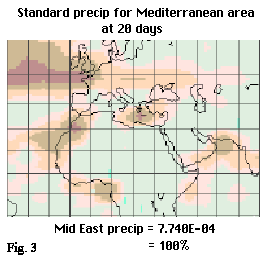
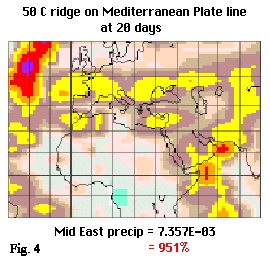
A second proposed possibility which would be consistent with the Algonquin Indian
legend is the impact of an ice comet. Information indicates that they may consist of a large
percentage of water with estimates at from 25 to 60 percent. The planet Pluto,
(there's been much discussion lately as to whether it is indeed a true planet),
has been estimated by one source to be up to 80% water. Many believe that Pluto
and its rather large moon Charon are Kuiper Belt objects and that there are many
other items nearing their size located in the belt.
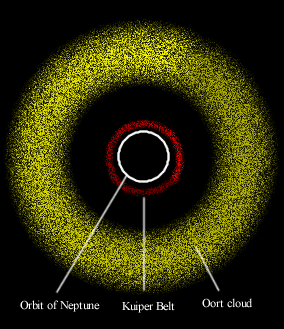 Fig 5
Fig 5
To greatly increase the amount of water on the earth would
require a rather large size object since the earth presently has approximately 340 x
10*6 cubic miles of water. A Pluto-type ice sphere of 320 miles in diameter would
increase the water on the earth by about 5 percent. Pluto itself is 1450
miles in diameter. One comet that recently visited our
skies was about 25 miles wide. It would be hard to imagine the catastrophic destruction
that the impact of a 320-mile wide ice comet would cause to planet Earth.
More reasonable would seem to be a swarm of small ice comets over a few days time
period. Quite possibly the Earth in its
orbit could enter a band of small ice comets which shower the Earth with a considerable
amount of water in a few days time period. Or also there is the possibility
of the Earth orbit encountering the remains of a large comet that was broken up
by impacts or encounters with the outer planets or their gravitational forces, or as
will be shown below, a comet broken up by the heating effects of our Sun.
Theoretically the larger outer planets such as Jupiter and Saturn work like sweepers to
clean up a lot of the space trash before it comes into the neighborhood of our
lesser planet Earth. For example the comet Shoemaker-Levy 9 impacted Jupiter over a period
of 7 days (July 16 - July 22, 1994) with 20+ observable fragments.
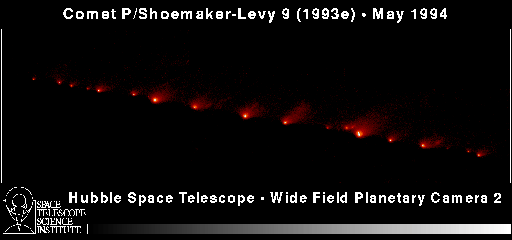 Fig 7
"Just before the first comet fragment hit Jupiter,
Zdenek Sekanina wrote that based on Hubble Space Telescope
observations in early July 1994 the fragments had effective diameters generally
between 1 and 2 kilometers: Although the evidence points to an apparently
continuing disintegration of the large fragments in numerous discrete events,
objects a few km across still seem to have been present in early July, and the
temporal variations in the effective diameters are likely to be
primarily a rotational effect of strongly irregular shape."
It can be estimated that prior to breakup and loss of much of the water content, the comet
was possibly between 10 to 12 miles in diameter.
Fig 7
"Just before the first comet fragment hit Jupiter,
Zdenek Sekanina wrote that based on Hubble Space Telescope
observations in early July 1994 the fragments had effective diameters generally
between 1 and 2 kilometers: Although the evidence points to an apparently
continuing disintegration of the large fragments in numerous discrete events,
objects a few km across still seem to have been present in early July, and the
temporal variations in the effective diameters are likely to be
primarily a rotational effect of strongly irregular shape."
It can be estimated that prior to breakup and loss of much of the water content, the comet
was possibly between 10 to 12 miles in diameter.

Fig 8, Comet 57P/du Toit-Neujmin-Delporte after splintering
into at least 19 fragments
from http://news.bbc.co.uk/2/hi/science/nature/2153650.stm
"Rabbi Moses Ben Nachman, a Jew living in Spain,
wrote of God taking two stars
from Khima and throwing them at the earth in order to begin the great
flood. (from "Comets in Ancient Cultures" By Noah Goldman U. Maryland, College Park Scholars) An
indicator that the flood comet appeared in the sky as a twin comet.
After being broken up and dispersed by the heating effects
of the sun while still in space the fragmented comet must enter
our atmosphere which is very hard on intruding high speed space objects!
A very large percentage of them are broken up or "exploded" by
the experience. Even iron meteorites such as the
Gibeon meteorite, 90% iron, which was apparently a large object that
burst high in the atmosphere and produced a debris field 70 miles
(120 km) wide by 230 miles (390k km) long.
The breakup was so complete that no major craters have ever been identified even though
many masses between 100 and 500 kg have been found, and
in the past few years an increasing number of small Gibeon
meteorites have been located as modern metal detection equipment
has allowed meteorite hunters to find the smaller specimens.
(see news stories on latest meteorite shower)
The majority of comet material would be considerably more fragile than that of
most meteorites or asteroids.
It should also be noted that any natural cause for the flood must be relatively
short-lived. In order for the larger animals and humans to survive, the area where
they landed should return to near normal in just a few seasons. The Biblical chronology
requires the heavy rains to stop after 40 days and for land to become dry enough for the
occupants of the ark to emerge after 1 year and 17 days. After 11 months and
18 days plant growth has to have reappeared when the dove returned with a plucked leaf.
And within a short time Noah was able to plant and harvest a vineyard. If the ocean
waters were heated considerably due to subsurface volcanic activity
along the mid-ocean ridges as proposed, it would take a relatively long time for
ocean cooling back to near normal, possibly as long as 500 years or more.
How long it would take to return to near normal growing seasons due to an ice
comet shower would seem to depend upon the size and number of comet fragments and
the percentage of solid material versus water contained within the comets.
The larger the number of fragments, the smaller the fragments and the higher the
percentage of water, the faster the Earth atmosphere and surface could return to
normal. The heavy rainfall from that portion of the comet's water that vaporized
in the atmosphere would clean the air and minimize the effect of dust clouding
from land impacts. Assuming a nearly optimal comet shower condition,
probably portions of the Earth could return to normal growing seasons in a
relatively short time, say within a decade or less.
Since the major portion of the Earth surface is water, the probabilities are
that most of the comet material that did not turn to vapor in the atmosphere and
reached the surface would impact on water covered areas. This would not be
inconsistent with the wording of the Scriptures since
the Hebrew words translated as "fountains of the great deep broken up",
can also be translated as "cleaved". In fact "to cleave" is the basic
meaning of this Hebrew word "baqa" (Strong's # 1234), which is the opening up
of an object due to a striking.
The ice comet shower would also seem to better fit the Biblical record in
that the heavy rains and great disturbances to the seas would start in a very short
time after the impact of the first fragment with the atmosphere and the seas,
and the heavy rains and the disturbances to the waters would start to decrease
not long after the last major fragment had impacted. Therefore, if a high water
content comet much larger than Shoemaker-Levy 9 was fragmented into say 100+ major
fragments and many, many smaller fragments and impacted the Earth over approximately
40 days the result would seem to closely fit the Biblical record.
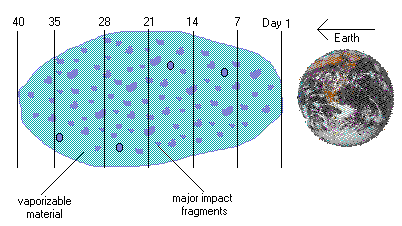 Fig 9
Fig 9
 Fig 10
Fig 10
Conclusion; We have briefly summarized some of the many tribal traditions that seem to
verify the Biblical account of the flood and presented only two of many possible
theorizations concerning how a natural phenomenon could possibly cause such a great
destructive event. See Appendix A and Appendix B for further expansion of the
multi-fragment ice comet shower concept which our research to date seems to indicate
as the most probable theory.
In attempting to visualize the true nature of the flood it might help to use the
following amplified translation of 2 Peter 3:6.
Whereby the world that then was,
being dashed down (washed down, deluged, overflowed) with water,
perished (was fully destroyed):
Therefore, one must consider the possibility that a large portion of the damage
of the flood was due to a "washing down" and "washing over" effect,
as with flash flooding and tidal waves, instead of the standard
interpretation of a deep standing flood of water that covered the entire globe.
Appendix A: COMET NOAH, a theoretical scenario
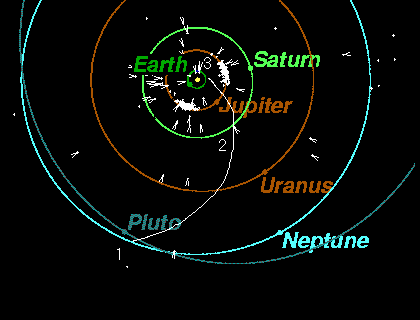 1 Kuiper Belt item Noah (KBNoah) leaves the belt possibly due to an encounter with
another Kuiper Belt item or an encounter with planet Pluto
1 Kuiper Belt item Noah (KBNoah) leaves the belt possibly due to an encounter with
another Kuiper Belt item or an encounter with planet Pluto
2 Breakup begins as ComeT Noah (CTNoah) nears the orbit of the inner planets
due to planet gravitational pull and heating effects of the Sun.
There is also the possibility of asteroid impacts. Its comet-type orbit is deflected
by the effects of the gravitational pull of the inner planets.
3 CTNoah comes under the attraction of Earth's gravity and as it enters the exosphere
break up accelerates due to higher gravitational effects and as heating starts due
to friction of the Earth's atmosphere. A major portion of the ice evaporates as
friction heat increases and becomes the heavy rains. That portion that does not
evaporate, both of the ice and the solid material, impacts with the Earth's surface.
A majority portion cleaves the surface of the seas and causes massive disturbances
to the seas and tidal waves that run onto the land. That portion that impacts with
the land causes surface disturbances, but the effect of fragments and dust being
kicked up into the atmosphere is mitigated by the heavy rain, as compared to the
what would happen with a dry asteroid impact. After 40 days the effects
of CTNoah are ended.
After effects:
The heavy rains and runoff have heavily eroded portions of the land. There is considerable
floating debris on the surface of the waters. With time, runoff and erosion continues; and the seas
slowly settle down. The pressures of the additional water cause earthquakes
and movements of the surface and sea bottoms resulting in both sinking and
rising of land surfaces. The atmosphere starts to clear
and the after effect rains lessen and the sea surface temperatures start to return
to normal. Growth starts again from roots and seeds that remain on or near the
land surface. After 1 year and 17 days it is safe for Noah, family and animal
friends to exit the ark.
Gen 8:16 “Go out of the ark, you, and your wife, and your sons, and your sons’ wives with you.
Gen 8:17 Bring out with you every living thing that is with you of all flesh, ... that they may breed abundantly in the land, and be fruitful, and multiply on the land.”
Just as it was at the end of creation phase six when the earth was finished
and a "very good" habitat for man and animal so that they could be fruitful and multiply,
so it was at the end of the flood! The flood did not cause a massive resurfacing of the earth,
instead it was cleansed and refreshed, ready for immediate reoccupation !!
Appendix B: Evidences from Paleoindian Sites,
Astronomical Observations, Postglacial Sea Levels,
Ice Cores, and
Archeological Discoveries
"Radiocarbon dating indicates that switching from Bølling to
Allerød to Younger Dryas climatic regimes during the Pleistocene-Holocene transition
caused regional hydrological conditions to change suddenly from desiccation and declining
water tables to rising water tables at essentially the same time across North America.
During Younger Dryas reduced evaporation due to colder temperatures caused what
precipitation there was to be more effective in recharging water tables (making black mats
and aquolls) and raising water levels in ponds and lakes (diatomites, marls and gyttjas).
How did this cause 32 genera of Pleistocene fauna to become extinct immediately prior to
the Younger Dryas event? Some have argued that extinction was gradual with species
dropping out at different times in the late Pleistocene or that a domino effect occurred as
the extinction of one group led to the extinction of another resulting in a crash of the
ecological system. These scenarios would have taken more time than the geochronology
allows.
The sudden extinction occurred at exactly the onset of the Younger Dryas deep freeze.
Therefore, climate change is very likely a significant factor. But it also occurred during a
time of depleted watering places and at the same time as predation by Clovis folk.
Therefore, what may have done them in was the sudden and dramatic climate change
combined with the hunting pressure on weakened animals concentrated at the few existing
watering places which may have been frozen over. On the other hand, the extinction is so
quick and complete that I wonder if something we really don’t yet understand happened
10,800 14C years ago at the real Pleistocene-Holocene boundary." ( From "Stratigraphic
Manisfestations of Bolling, Allerod, and Younger Dryas Climate at Paleoindian Sites
in North America and the Causes of Extinction" by C. V. Haynes, Jr.; available at
http://geology.er.usgs.gov/eespteam/workshop/abs.html. )
----------
"Dr. Clube ascribes other events including the Old Testament story of Noah and
his Ark to a Dark Age linked with colliding heavenly bodies. He also believes
that climatic changes, including fears of present global warming, may have a
cosmic component. There is sufficient evidence, he says, to indicate that
collisions happen within centuries and millenniums rather than millions
and billions of years, with multiple encounters more likely than sceptics claim. "
("A cosmic trail with destruction in its wake",by Nick Nuttall
Times Newspapers Limited The Times, May 24, 1990, Thursday)
"Abstract:
The structure of the Taurid meteoroid complex is investigated using orbital element
measurements from the IAU Meteor Data Center. The complex is found to have been
formed during the last about 10 kyr, this time-scale corresponding to a probable
late stage in the evolution of the parent object, a giant comet which was apparently
captured into a small-perihelion, short-period orbit about 20 kyr ago and which,
in an initial highly active phase, gave rise to the material that now broadly
constitutes the zodiacal cloud. Models of the evolution of the complex under
gravitational perturbations suggest that meteoroids must have originally left
the parent object near perihelion, but also allow the possibility that fragmentations
have occurred when large disintegration products collided with objects in the
asteroid belt."
( "The structure and evolution of the Taurid complex", STEEL, D. I.; ASHER, D. J.; CLUBE, S. V. M.
,Royal Astronomical Society, Monthly Notices (ISSN 0035-8711), vol. 251, Aug. 15, 1991, p. 632-648)
----------
Also Alexander Tollmann, "a professor in the institute of geology at the University of
Vienna, compared the numerous myths of a great flood, recorded in almost every
prehistoric civilisation, with the geological evidence for a comet impact at
about the same time. He used the two sources of information to date the flood
very precisely, to around the year 9,600BC.
Two discoveries are central to his claim. One is the distribution of the
splinters of molten rock thrown up by the impacts, known as tektites. There was,
he said, a huge concentration of them in sediments laid down about 10,000BC.
Variations in the amounts in different parts of the world suggested Earth was
hit by seven large fragments and many smaller ones.
The other is the apparent sudden increase in radioactive carbon-14 found in
fossilised trees dating back to the same era. This, said Tollmann, was due to
the destruction of the ozone layer by the comet, an event that exposed the
atmosphere to higher levels of radiation and increased carbon-14 production."
(From http://www.nando.net/newsroom/ntn/health/042296/health11_25615.html)
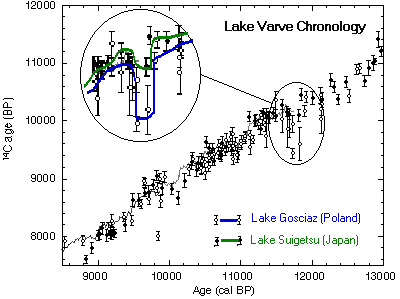
Modified Fig. PE-4 from http://www.cio.phys.rug.nl/HTML-docs/Verslag/97/PE-04.htm
----------
We also find a similar time estimate from postglacial sea level data and from
the sea level data we get a very rough estimate of the size for the ice comet.
"As the last great ice sheets thinned, retreated, and disappeared, their
water was returned to the oceans. Radiocarbon dating of drowned
reefs, swamps, coastal features, and river channels allows the
reconstruction of both the rapid decay of ice sheets and the gradual climb
to present sea level. Rapid sea level rise about 12,000 years ago
may represent the major decay of the Scandinavian Ice Sheet, and about
9000 years ago, the Laurentide."
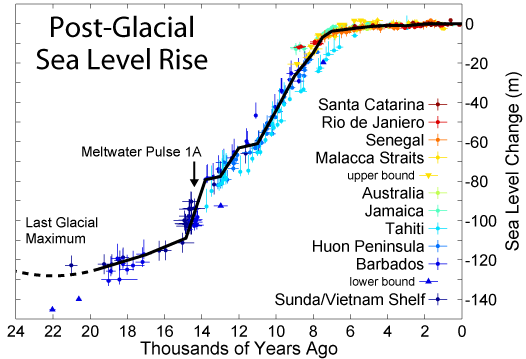
"The Laurentide Ice Sheet had nearly disappeared by about 5000 years
ago, thus the last 10 m of sea level rise cannot be explained by ice sheet
decay. Thermal expansion of ocean waters and isostatic
uplift of the shallow North Sea and Hudson Bay (spilling their water
into the larger oceans), are the most likely explanations."
( From "A Primer on glacio-eustatic sea levels" at http://www.homepage.montana.edu/~geol445/hyperglac/eustasy1 )
They are saying that they cannot really explain the estimated last 10 meters of sea level
rise for the last 5000 or so years (The Scholl study in Florida indicates only
a 2 meter rise in the last 5000 years.). Not often discussed is the fact that all data has an error band,
and in the case of data derived from C14 dating methods there is considerable error,
see Appendix C below, and also due to interpretations of the physical evidences made
by each individual researcher. The plot below from http://cima.iprm.edu/~morelock/sealvl.htm
illustrates the disagreements from different research studies and the uncertainty
spread at 10,000 BC becomes quite large. "One alternative supports a smooth sea level rise, while the other points to pulses in the
addition of meltwater to the world oceans. While the picture is far from a clear and universally accepted,"
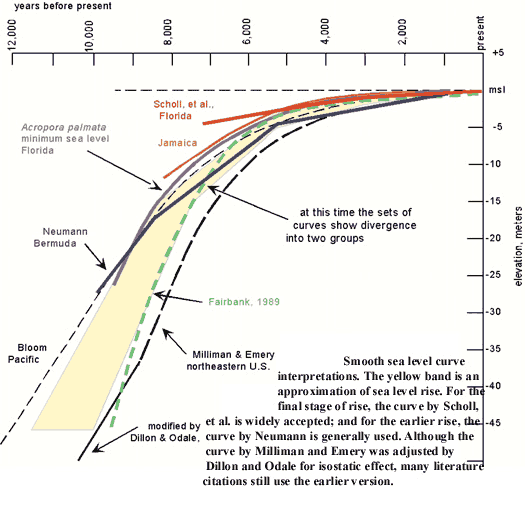 Therefore, there are many possible curve shapes that can
fit within the wide error band that their data has. Including a sudden rise of
sea level due to a comet induced flood followed by a relatively rapid melting of
the ice sheets due to a sudden warming of the climate. The below indicated 13 degree temperature
rise in less than 50 years at the close of the Younger-Dryas would be quite
catastrophic.
Therefore, there are many possible curve shapes that can
fit within the wide error band that their data has. Including a sudden rise of
sea level due to a comet induced flood followed by a relatively rapid melting of
the ice sheets due to a sudden warming of the climate. The below indicated 13 degree temperature
rise in less than 50 years at the close of the Younger-Dryas would be quite
catastrophic.
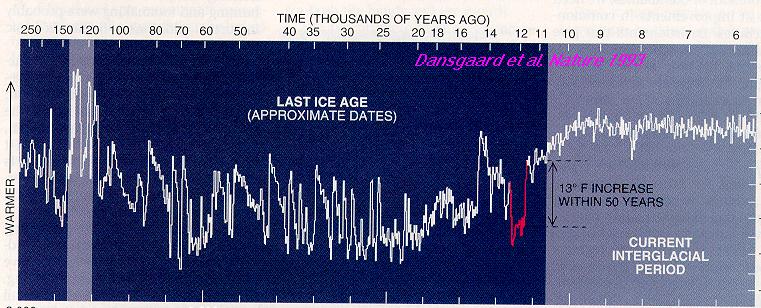
We also see a shift in the recorded icecore acid (SO4) levels in the
data plot shown below. (Most probably there is
a discontinuity in the icecore at this point.)
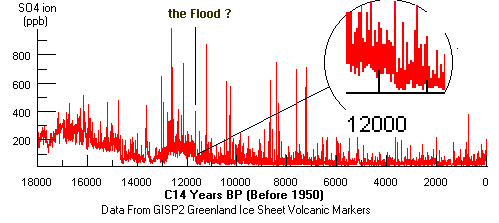 Zooming in a little closer and looking at particle Accumulation and ECM (electrical
conductive measurement, considered as a measurement of acidity), we see in both curves
a spike due to volcanic activity and in the Accumulation plot it is preceeded
by a data pulse that appears to not be associated with the volcanic activity.
Obviously we would like to firmly state that this is particle accumultaion due to the
proposed comet encounter, but actually the data is just not that reliable with
unexplained pulses in other areas, and then there is also the strong probability of a
short discontinuity in the data at this point.
Zooming in a little closer and looking at particle Accumulation and ECM (electrical
conductive measurement, considered as a measurement of acidity), we see in both curves
a spike due to volcanic activity and in the Accumulation plot it is preceeded
by a data pulse that appears to not be associated with the volcanic activity.
Obviously we would like to firmly state that this is particle accumultaion due to the
proposed comet encounter, but actually the data is just not that reliable with
unexplained pulses in other areas, and then there is also the strong probability of a
short discontinuity in the data at this point.
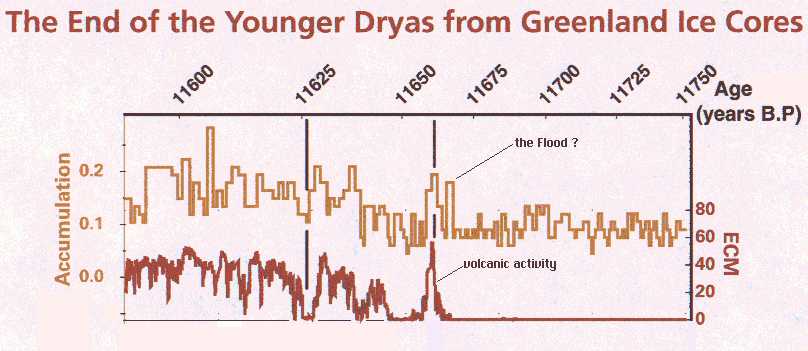
Taking a look at the sudden sea level changes of Lake Van (near Mt. Ararat) as
shown in the figure below, we see an increase in the levels at approximately
the time period of interest. The problem here is the dating errors and accuracy for
each of the respective studies. The Ice Core Working Group in their publication
of May 1998 proposed that their dating was within 2 percent for the periods in
question, which would give possible errors of around 300 years. The Lake Van working
group says "The age correlation between the Lake Van sediment and the Greenland
ice core chronologies is very good for the Holocene, but a time difference of 570
(GRIP) or 730 (GISP2) years between the Late Pleistocene chronozones
(Fig. 3; e.g. Grootes et al. 1993; Cuffey et al., 1995; Dansgaard et al., 1993)
exists, which need further investigation." And we would further propose that they
possibly got it a few years wrong in their correction , and instead the
end of Younger-Dryas could possibly correspond to the sharp spike in sediment deposition for
Lake Van. The data from seven studies including tree rings, varves, coral dating, and
Greenland ice cores indicates the termination of the Younger Dryas to be within a range
from 10,447 to 11,700 yr. B.P. ( avg. 11,074 +- 627 ) (from Paleo 122(1996)p.114,Table 2).
The indicated time of the sediment deposition spike at approx. 10,500 yr. B.P. is just
within the the lower end of this range.
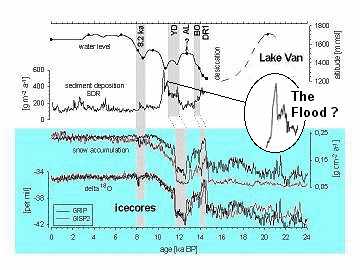
(modified fig. 3 from http://www.tu-darmstadt.de /fb/geo/gpi/landmann/abstract/ gusdvs.htm)
They describe the condition of the core sample at the time of the sharp spike in
sediment deposition as follows:
"At around 10,500 yr B. P. a conspicious layer,
consisting of 7-10 dark brown, thick varves ..., was deposited in Lake Van. Biomarker
analyses of this organic carbon rich layer ... showed, that the lipid fraction
consist mainly of longchain alkenones ... The author concludes that Prymnesiophyceae were
the primary producers and suggests that a mixing event, following a long
time of stagnation, led to the enrichment of nutrients in the lake water."
(from Palaeo 122(1996)p.115)
We obviously would propose that "the flood" was the suggested "mixing event".
----------
To obtain our very rough estimate of the minimum comet size, we are
at the minimum assuming that it was the proposed multi-fragment ice comet shower that contributed
the approximately 10 meter of sea level rise at 10,000 BC, instead of the other proposed theories.
Then the estimated minimum ice comet size would be 120
miles in diameter, assuming 80% water content.
----------
We also get a rough confirmation of the proposed date of the flood from
archaeological data concerning the place and time of the beginning of Neolithic
agriculture, consistent with Genesis 9:20 "Noah, a man of the soil, began the planting ..."
(NEB)
"The cradle of agriculture generally has been placed in the Jordan Valley of the
southern Levant (today's Israel and Jordan). But work by Simcha Lev-Yadun of
Israel's Agricultural Research Organization and colleagues suggest the first
farms may have been farther north, between the Tigris and Euphrates rivers in
what is today northeastern Turkey and northern Syria.
Wild progenitors of the main Neolithic founder crops (einkorn wheat, emmer
wheat, barley, lentil, pea, chickpea, bitter vetch, and flax) are found
together only in this small core area of the Fertile Crescent.
Lev-Yadun reports that wild chickpea especially is extremely rare, yet it
was a staple crop of Neolithic life 10,000 years ago. Agriculture, therefore,
probably began in an area where chickpea is native. Archaeological evidence
shows that the earliest known farming settlements of the Fertile Crescent
were in this core area.
Also, the limited genetic variability of these crops implies that they were
domesticated only once — rather than by several different cultures at roughly
the same time. Evidence of domesticated crops in the core area dates to about
10,000 years ago, while the earliest signs of farming elsewhere are about 9,300
years ago.
Neolithic sites discovered in the core area indicate that a society with plenty
of food thrived there. In sites such as Cayonu, Novali Cori, and Gobekli Tepe,
impressive architecture, images, and artifacts have been found. Settlement sites
are also larger in this area than many others of the same time in other parts of
the Fertile Crescent. ..."
(From "The Cradle of Agriculture? New Evidence Moves the World's First Farmers
into Turkey" by Reagan Duplisea, http://www.discoveringarchaeology.com/ articles/
060100-turkeyfarm.shtml)
----------
Recent genetic studies indicate that at one or more times in human history
only a very few individuals were the genetic source, consistent with the historical
flood accounts. If one uses the standard 25 years per generation, the flood at
some time between 10,500 and 11,500 yr. B.P. would be very roughly between 420
and 460 generations ago. ( The possiblility of increased longevity not being considered.)
"indicate that the action of natural selection
against deleterious mutations has been relatively weak over the six-million-year
period. This suggests either that the human population has been through one or more
severe reductions, or 'bottlenecks', or that only a small proportion of people in
any given generation passes its genes on to the next generation – or both. Either
way, the effect will be to enhance random sampling effects at the expense of natural
selection. The effect of this may have been that, over the millennia, a large number
of slightly deleterious mutations have become fixed in the human population."
(from "Six million years of degradation",Macmillan Magazines Ltd 1999 - NATURE
NEWS SERVICE, http://www.nature.com/nsu/990204/990204-2.html)
APPENDIX C: a CAUTION concerning C-14 dating
"Plant materials (wood, charcoal, textiles, grain etc.) are generally
considered the best sample types for C-14. Apart from contamination, other
factors can cause an apparent age. Some species of hardwoods live several
centuries, and the C-14 result should represent the date of the rings present in
the wood or charcoal sample. Furthermore, dates on plant materials grown in
regions of volcanic activity may be older than the true age because of a natural
dilution of the local atmospheric C-14 by volcanic gases. Saup‚ et al (1980)
investigated the C-14 result of 5730 BP on wood from a mine shaft believed to be
Roman or Etruscan. Plants growing in this region of volcanic emissions (Monte
Amiata, Tuscany, central Italy) gave fictitious dates of 1805, 2540 and 4350
years BP. Discrepancies of up to 20% between C-14 results and historical data in
the Aegean and in Egypt are thought to derive from minor atmospheric variations
(Hood 1978).
Divergence of the C-14 age from the historically dateable context is clearly
the best, perhaps the only, method of evaluating the effects of contamination.
While it is indisputable that C-14 does give results generally harmonious with
the expected historical age, the exceptions are manifold, even with optimum
sample material and site conditions. In a series from historical sites in
Yugoslavia (Srdoc et al 1981), wood samples of the 13th century gave dates of
240 and 580 BP, a 14th-15th century sample gave 940 BP, 1st-2nd century B.C.
samples gave 2170, 6030 and 5600 BP, and a Neolithic sample gave 1940 BP. The
site of Akrotiri in Greece, destroyed by the Thera eruption of ca. 1550 B.C. and
sealed with an ash layer 3m. deep, was thought to be "an ideal source for
radiocarbon samples." A recent series of eight samples yielded only four results
deemed reliable: two dates "are exceptionally early and do not fit into the
archaeological picture," two other dates "are very late and were probably
contaminated'' (Weinstein and Michael 1978). All of the samples were grain or
charcoal of short-lived wood, and all were found in jars in one room. Regarding
the early dates, the authors remarked:
"Why are they so early? Are there special factors or phenomena
surrounding the Akrotiri samples of which the radiocarbon specialists are
unaware? At present, the series II dates are certainly of little or no value
for Minoan chronology."
Betancourt et a1(1978:202) also discuss several dates that are too early or
too late in the expected historical chronology, and conclude:
"One or two dates should never be used by themselves to establish a
site's chronology. So many dates have proven to be useless because of
contamination and other causes that one can only establish a radiocarbon
chronology with some degree of confidence if several dates from the same site
fall into a consistent pattern that agrees with the stratigraphic
sequence."
Possible contaminating agents are many and varied, as described above. Unless
there are specific conditions which warrant specialized pretreatment, most
laboratories process samples with acid and alkali washes. While this standard
pretreatment is usually effective in removing modern contaminants, it may not do
so for intrusive materials deposited much earlier. The well-known controversy
over the earliest date (pre-10,000 B.C.) from Meadowcroft rockshelter in
Pennsylvania hinges on an alleged gradual contamination of the charcoal samples
through the injection of dead carbon in the form of coal particles or of organic
solubles (Haynes 1980; Dincauze 1981), in spite of the fact that the cave is dry
and its earliest cultural layer is well sealed. One of the proponents of
contamination, C. Vance Haynes, was a pioneer of chemical pretreatment methods
to remove plant debris from C-14 samples. He points out that the dated samples
from Meadowcroft are not pure charcoal but "mixtures of finely divided carbon
and carbonaceous matter with... a significant percentage of soluble organic
matter" (1980:583). Humate extractions were dated some 10,000 years earlier than
the residual material in one sample. Cook (1964) investigated apparent charcoal
samples from archaeological sites using chemical procedures similar to but
stronger than those of C-14 pretreatment, and concluded that many were decayed
wood with "considerable amounts of organic matter produced by micro-organisms
through past centuries." Others were partially burned (carmelized) wood with
considerable infiltration of organic matter.
Another famous early man site in North America, the Old Crow site in the
Yukon territory of Canada, also yielded very misleading C-14 results according
to a recent study by Nelson (1986). Bone tools from the site had given a date of
around 27,000 years B.P. These tools were made of caribou ribs, and Nelson found
that the outer portions of the bone had exchanged carbon with the air and ground
water. A sample taken from the innermost portion of the bone yielded an age of
1,350 years. As in the Meadowcraft samples, the dating of progressive fractions
revealed discrepancies not apparent when the samples were subjected to
traditional pretreatment and dated.
My own investigation of a "charcoal" sample dated 8500 BP from a geological
context in Hong Kong led to uncertainties inherent in the dates on wood samples
from certain depositional environments. The wood was taken from a marine clay
18m. Below sea level; it was jet black as if charred. Laboratory examination
(Grisack 1985) revealed however that the cellulose structure did not exhibit the
morphological changes associated with charring. Scanning electron microscope
study revealed that the pore spaces of the cellulose were almost completely
filled. The analytical spectrometer showed the main inorganic substances present
were sulfur and iron, with lesser amounts of silicon, aluminium, calcium and
sodium. Treatment with 50% hydrochloric acid was effective in removing inorganic
materials, but under the SEM the pore spaces remained as occluded with debris as
before. The sample also showed very little birefringence under polarized light,
whereas wood fibers should be brightly birefringent. "The explanation that
suggests itself is that some organic type material has slowly, over a long
period of time, been filtering into the lumens of the wood and possibly the cell
walls as well, displacing the cellulose or carbon" (Grisack 1985:3). In the
opinion of F.H. Kendall, Director of the: Radioisotope Unit at the University of
Hong Kong, standard C-14 pretreatment of wood and charcoal samples would not
succeed in removing organic material translocated into the lumens and cell walls
of the cellulose (personal communication 1985).
It is clear that "more research on dating technology needs to be conducted so
that the reliability of dates can be assessed" (Stanford 1982:205).
MacDonald(1983:100, 108) believes that the absorption of humates from ground
water may have seriously contaminated many dates from the northeastern US with
its particularly acidic soils:
"The critical question that demands immediate attention is that
of humic acid contamination of C-14 dates, since there is growing evidence
that current lab pretreatments are inadequate and that we are confounded by
dates that may in some cases be too old and in other cases too young
..."
In sum, it should be obvious to the non-specialist, as it is to most
archaeologists and radiocarbon scientists, that possible contamination always
represents an element of uncertainty which no amount of laboratory pretreatment
or measurement can totally efface. Clusters of congruent dates on different
materials, replicated at different sites, eventually allow for a reliable
radio-carbon chronology to be established, but there is, quite simply, no
possibility of an absolute date on a single sample or artifact." ( from
http://www.shroud.com/meacham.htm by William Meacham )
-------------------
"The radiocarbon age scale that would be calculated from first principles (based on
the decay rate of the 14C isotope, assuming that 14C was at the same level of
abundance as it is at present) is not always reliable, because there have been
fluctuations in the rate of production in 14C at the top of the atmosphere.
The problems are particularly great at about 10,000 14C y.a., when a large influx
of 14C-depleted carbon from the oceans, combined with a decrease in the rate of
14C production at the top of the atmosphere, gives an 'age
plateau' such that the same 14C age covers a wide span of real time, about 1,000 years."
14C years ago=>Calibrated ('real') years ago
1,000 => 1,000
2,000 => 2,000
2,500 - 2,800 => 2,600
(sudden shift in atmospheric 14C content)
3,000 => 3,200
4,000 => 4,500
5,000 => 5,900
6,000 => 6,950
7,000 => 7,900
8,000 => 8,900
9,000 => 10,000
10,000 => 11,200 - 12,200
('radiocarbon plateau')
11,000 => 12,900
12,000 => 14,000
13,000 => 14,500
15,000 => 17,000
16,000 => 19,500
17,000 => 21,000
18,000 => 22,500
20,000 => 24,500
25,000 => 28,000
30,000 => 35,000
40,000 => 45,000"
(from: http://www.esd.ornl.gov/projects/qen/nerc14C.htm)
However, good results are possible, "Radiocarbon dating was used to show that the chronology of Egypt's Old,
Middle and New Kingdoms is indeed accurate. For the first time, radiocarbon dating
has become precise enough to constrain the history of ancient Egypt to very specific dates,"
(ref: Radiocarbon-Based Chronology for Dynastic Egypt:
Christopher Bronk Ramsey1,*,Michael W. Dee1,
Science 18 Jun 2021. Vol. 328, issue 5985, pp. 1554-1557 DOI: 10.1126/science.1189395)







 Fig 5
Fig 5
 Fig 7
Fig 7
 Fig 9
Fig 9
 Fig 10
Fig 10









